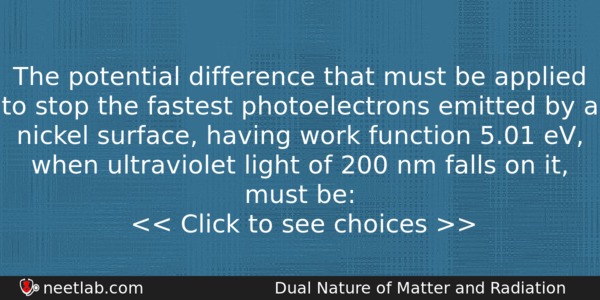| ⇦ | 
| ⇨ |
The potential difference that must be applied to stop the fastest photoelectrons emitted by a nickel surface, having work function 5.01 eV, when ultraviolet light of 200 nm falls on it, must be:
Options
(a) 2.4 V
(b) – 1.2 V
(c) – 2.4 V
(d) 1.2 V
Correct Answer:
1.2 V
Explanation:
Kₘₐₓ = hc / – W = hc / λ – 5.01
= 12375 / λ(in Å) – 5.01
12375 / 2000 – 5.01 = 6.1875 – 5.01 = 1.17775
= 1.2 V
Related Questions: - The maximum velocity of a particle, executing simple harmonic motion with an amplitude
- A tangent galvanometer has a coil of 50 turns and a radius of 20 cm. The horizontal
- Point masses m₁ and m₂ are placed at the opposite ends of a rigid rod of length L,
- Shear modulus is zero for
- The number of photo electrons emitted for light of a frequency v
Topics: Dual Nature of Matter and Radiation
(150)
Subject: Physics
(2479)
Important MCQs Based on Medical Entrance Examinations To Improve Your NEET Score
- The maximum velocity of a particle, executing simple harmonic motion with an amplitude
- A tangent galvanometer has a coil of 50 turns and a radius of 20 cm. The horizontal
- Point masses m₁ and m₂ are placed at the opposite ends of a rigid rod of length L,
- Shear modulus is zero for
- The number of photo electrons emitted for light of a frequency v
Topics: Dual Nature of Matter and Radiation (150)
Subject: Physics (2479)
Important MCQs Based on Medical Entrance Examinations To Improve Your NEET Score
18000+ students are using NEETLab to improve their score. What about you?
Solve Previous Year MCQs, Mock Tests, Topicwise Practice Tests, Identify Weak Topics, Formula Flash cards and much more is available in NEETLab Android App to improve your NEET score.
Share this page with your friends

Leave a Reply